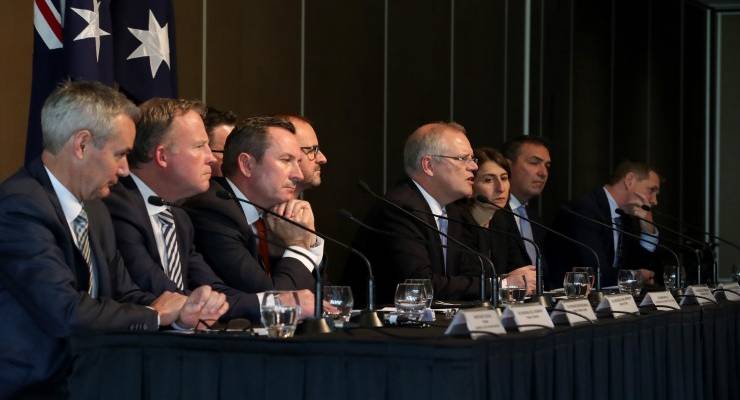
On Friday, NSW Premier Dominic Perrottet unilaterally fired a cannonball at Fortress Australia, announcing an end to all quarantine restrictions on vaccinated travellers entering the state from November 1. NSW, Perrottet said, was opening up to the world.
It’s hugely telling that such a seismic shift in Australia’s COVID response didn’t come from Scott Morrison. At a press conference that afternoon, the PM tried to claw back control. Most foreigners, holiday-makers, and international students wouldn’t be allowed in just yet. The feds still control visas.
“They are decisions for the Commonwealth government, as the premier and I know,” he told reporters at Kirribilli House.
Despite that rebuke to Perrottet, the whole moment was a sign of just how much Morrison’s authority over managing the next phase of the pandemic had eroded, as NSW made a clear diversion from the national plan.
States going their own way
Before COVID, most Australians probably didn’t think too much about what living in a federation actually meant, beyond State of Origin and those weird, parochial debates about potato cakes/scallops. Now, Annastacia Palaszczuk gets to decide whether you’ll be able to see your family for Christmas. And while Morrison occasionally fumes about this, there’s little he can do to force the hand of Queensland, South Australia, Western Australia, Tasmania and the Northern Territory. Constitutionally, that’s what living in a federation means. Politically, there are important seats in all those states, and people there tend to like not having COVID around.
The sidelining of Morrison began during those chaotic weeks in March last year, when the pandemic suddenly started to get very real. Over a weekend, Dan Andrews and Gladys Berejiklian had to drag Morrison toward going harder and faster to stop the spread of the virus, pressuring him in a WhatsApp group before briefing gallery journalists on their plans for state-wide shut-downs before the prime minister got up to speak.
Looking back, despite Morrison later announcing national restrictions and economic support packages, that was the moment premiers took control. Soon after, states were starting to slam their borders shut to the rest of the country, a situation unheard of since the Spanish Flu more than a century ago.
“We’ve got a moat and we’re not afraid to use it,” the front page of The Mercury roared, when Tasmania cut itself off from the country. At the time, it seemed shocking. Now, it’s Perrottet’s decision to allow people in without quarantine that causes surprise.
What is also surprising is that NSW and Victoria, the country’s two biggest states, didn’t close their border until July last year. But since then, states have become far more reliant on border lockouts as an early line of pandemic defence, with often absurd results. Victoria’s traffic light permit system (introduced only in December) means that until the state exits lockdown on Thursday, a Sydneysider could drive to Melbourne before a Melburnian could travel 15km across the city. Last week Queensland closed its border to Tasmania over a single COVID case, and anyone coming in will need to do hotel quarantine.
Most absurd is the NSW-ACT border. As it stands, Canberrans can enter anywhere in regional NSW, except Greater Sydney. But if they travel further than a specific set of approved postcodes (which the territory government expanded, reluctantly, on the weekend), they will have to apply for a special exemption, and quarantine.
And all of this comes at a cost of family separations, children denied vital medical procedures, and a sense this is all a discomfiting new normal.
How long will it last?
The increasing reliance on internal border restrictions, a uniquely Australian response to the pandemic, is largely thanks to two things. The first is that there’s been a starkly different experience of COVID in different states. Thanks to WA’s geographic isolation, and Queensland’s dumb luck, people in both states have lived very free lives. When borders reopen — even McGowan and Palaszczuk are incrementally changing their messaging to grapple with this reality — those lives will start to become less free.
The second is the High Court’s ruling last November, where it unanimously rejected a constitutional challenge to WA’s border restrictions brought by Clive Palmer. That’s pretty good authority that as long as the virus is around, and our vaccination rates are what they are, border restrictions are valid.
But the incredible reliance on them, and the way locking out the country has turned relatively mediocre premiers into rockstars, makes them an incredibly tempting tool in a state government’s arsenal even beyond COVID. Earlier this year McGowan hinted at maintaining restrictions to stop the meth trade. The only way to really tear down the restrictions is through the courts. But Palmer first brought his case in July last year, and the High Court’s delivered its ruling in November, with full judgment released in February. There’s a time-lag here that means borders could theoretically be slammed shut in the short-term.
Perrottet’s announcement on Friday infuriated Queensland’s government, which accused him of abandoning the national plan. But long before Morrison announced it, we knew just how powerful premiers could be. It’ll be hard getting them to relinquish that power.








Crikey is committed to hosting lively discussions. Help us keep the conversation useful, interesting and welcoming. We aim to publish comments quickly in the interest of promoting robust conversation, but we’re a small team and we deploy filters to protect against legal risk. Occasionally your comment may be held up while we review, but we’re working as fast as we can to keep the conversation rolling.
The Crikey comment section is members-only content. Please subscribe to leave a comment.
The Crikey comment section is members-only content. Please login to leave a comment.